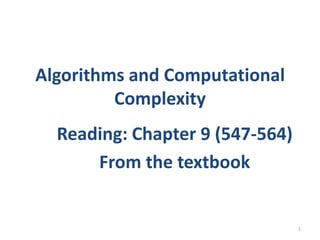
Lecture 3 complexity
- 1. Algorithms and Computational Complexity Reading: Chapter 9 (547-564) From the textbook 1
- 2. Time Complexity • The subject of the analysis of algorithms consists of the study of their efficiency. • Two aspects of the algorithm efficiency are: 1. The amount of time required to execute the algorithm 2. The memory space it consumes. • In this chapter we introduce the basic techniques for calculating time efficiency (Time complexity). 2
- 3. Dominant Operations The following main operations are used in the algorithms • Assignment(⃪) • Comparison(=, ≠, <, >, ≤, ≥) • Arithmetic operation(+, -, ×, ÷) • Logical operations(and, or, not) How long does each of these operations take to execute? • In general, assignments are very fast ,while other operations are slower. Multiplication and division are often slower than addition and subtraction. 3
- 4. Time Complexity • The running time of an algorithm is defined to be an estimate of the number of operations performed by it given a particular number of input values. • Let T(n) be a measure of the time required to execute an algorithm of problem size n. We call T(n) the time complexity function of the algorithm. • If n is sufficiently small then the algorithm will not have a long running time. 4
- 5. Time Complexity • How fast T(n) increases for large n? This is called the asymptotic behavior of the time complexity function, basically we will be focusing on the leading term of T(n). • In our time analysis we will restrict ourselves to the worst case behavior of an algorithm; that is, the longest running time for any input of size n. 5
- 6. Example • If T(n) = 4n3 + 2n2 + n + 5 then T(n) = n3(4 + 2 1 5 ) 2 3 n n n and for large n we have T(n) ≃ 4n3. • We say that T(n) has a growth of order n3. • We say that one algorithm is more efficient then another if its worse case running time has a lower order of growth. 6
- 7. Exercise What is the run-time complexity based on n for the following algorithm segment: 1. for i = 1 to n do 1.1 for j = 1 to n do 1.1.1 A(i,j) ⃪ x Solution The inner loop 1.1 is executed n times and the outer loop 1. is also executed n times. Hence, T(n) = n2 so that the growth is of order n2. 7
- 8. Exercise Estimate the time complexity of the following algorithm: 1. i ⃪ 1 2. p ⃪ 1 3. for j = 1 to n do 3.1 p ⃪ p × i 3.2 i ⃪ i + 1 Solution It takes two assignment statements 1. and 2. to initialize the variables i and p. • The loop 3. is executed n times, and each time it executes two assignment statements and two arithmetic operations 3.1 and 3.2. • Thus, the time complexity of the algorithm is given by T(n) = 4n + 2 so the growth is of order n. 8
- 9. Remark • In the latest algorithm, the dominant operation is the multiplication of 3.1. • Because multiplication takes more computer time to execute, we only count in this case the number of multiplications. Thus T(n) = n (multiplications) • In an algorithm, certain operations are usually dominant, so T(n) would be the number of dominant operations to accomplish the task. 9
- 10. Order of Growth-O(g) notation • In the latest two problems we found a precise expression for the time complexity of the algorithm. What usually interests us is the order of growth. • Let g : ℕ ⟶ℕ . We say that a function f is order at most g or f “big O” of g if and only if there exists positive constant C and n0 ∈ ℕ such that |f(n)| ≤ C|g(n)|, for n ≥ n0 We write f(n) = O(g(n)). 10
- 11. Example Find the minimum number of multiplications needed to calculate x13? Solution • suppose x13 is expressed as x13 = x × x ×…× x, 12 multiplications needed • If it is expressed as x13 = x8 × x4 × x then x2 = x × x, x4 = x2 × x2, x8 = x4 × x4.Hence x13 = x8 × x4 × x, 2 + 2 + 1 = 5 multiplications needed. 11
- 12. Example Two algorithms, A and B ,have time complexities f and g respectively, where f(n) = 3 n2 - 3n + 1 and g(n)=n2.Determine which algorithm is faster. Solution First, find the value of n such that f(n)=g(n).Thus n2 = 3 n2 - 3n + 1 2 n2 - 3n + 1 = 0 (2n - 1)(n - 1) = 0 n = 1/2 or n = 1 12
- 13. Example Take the larger value of n, that is for n > 1, suppose n = 2,then f(2) = 3(2)2 - 3(2) + 1 = 7 and g(2) = 22 = 4 Thus g(n) < f(n) for all n > 1.Hence g(n) is faster, so algorithm B is faster 13
